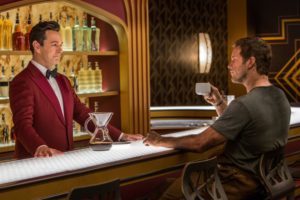“Passengers” heralds a simple concept – a sci fi scope with a human element – that is much more complex than it’s been given credit for. It stars Chris Pratt and Jennifer Lawrence as two passengers aboard a spaceship heading toward a paradise called Homestead II, a place for people leaving Earth (full reasons why a vessel of 5,000 people aboard this ship need to leave Earth are not fully disclosed) to populate a new wonderful world that awaits.
However, something goes wrong. A meteor strikes the ship full of passengers all in hibernation. Only one pod, holding James Preston (Chris Pratt) malfunctions. He awakes to a barren ship devoid of any human life. A CGI hologram brings him through the waking process. But some exploration later, and Jim discovers a horrifying truth: he alone has woken up, 90 years before the ship will reach its destination. He’s meant to live out a solitary life and die alone aboard the doomed vessel.
“Passengers” has a lot in common with other movies, it’s plot a conglomerate of trapped in space movies like “Alien” coupled with the anguishing solitude offered in the seminal “Castaway.” Jim doesn’t come to grips wth his fate well. He does things like strike up a quasi relationship with an android bartender named Arthur (Michael Sheen), in between unsuccessfully attempting to break into the ship’s control center and having full on meltdowns as he begins to toy with the fact that he may, in fact, die alone. However, Director Morten Tyldum and writer Jon Spaihts layer drama on top of this as another passenger, the beautiful Aurora (Jennifer Lawerence) also awakens. It isn’t long before her and Jim strike up first a bond, then friendship, and an ultimate romance.

“Passengers” is filmed beautifully, the result of blending futuristic CGI with that of a cold, metal ship that seems starkly empty without the rest of its passengers. We see dining rooms that resemble prison mess halls, dispensing boring black coffees to Jim, and slightly more to Aurora, as she is a “gold” passenger.” There’s also the fact that the ship is pitched in a perpetual darkness; the result, no doubt, of a lack of light from the skies of deep space and the ship’s low power mode as most of its inhabitants – crew included – are in suspended animation.
There are two exceptions to this rule, both filmed with splendor. First, there’s the bar manned by Arthur, reminiscent of the hues used in Stanley Kubrick’s eerie “The Shining,” but without the sense of insanity and horror that film offered. Before he meets Aurora he drinks out of desperation, a habit that begins to border on serious alcoholism, as he is awake alone for over a year. After he meets Aurora, he drinks champagne and toasts to a wonderful life. And, in the film’s most amazingly visual sequence, the two celebrate her birthday as the ship passes a red giant star. The scene imbues all the emotion of what that would feel like, and Cinematographer Rodrigo Prieto invites us into this marvel with amazing reality.
The film is scored wonderfully, not a score of hit songs and familiarity, but one of low, droning bass, otherworld electronic sounds, and an ethereal feeling throughout. The ship’s quarters and accommodations may have much in common with 2005’s “The Island,” but here are more immediate and more fitting. “Passengers” is, at heart, a human film with sci fi touches, and balances both with remarkable ease.
At the end of the day, “Passengers” delivers a unique experience, one audiences are not used to seeing, and one that sticks with you after the credits roll. It’s not perfect, and has some cliched happenings and an ending that feels a little too convenient and a little too familiar. But the film works. It’s escapism at its truest sense, and sci fi in a way films like “GATTACA” reminded us they could be, amidst modern films that go for explosions and CGI over real emotion. A pleasing film, and even with its PG-13 rating, is accessible to just about anyone.
– by Mark Ziobro